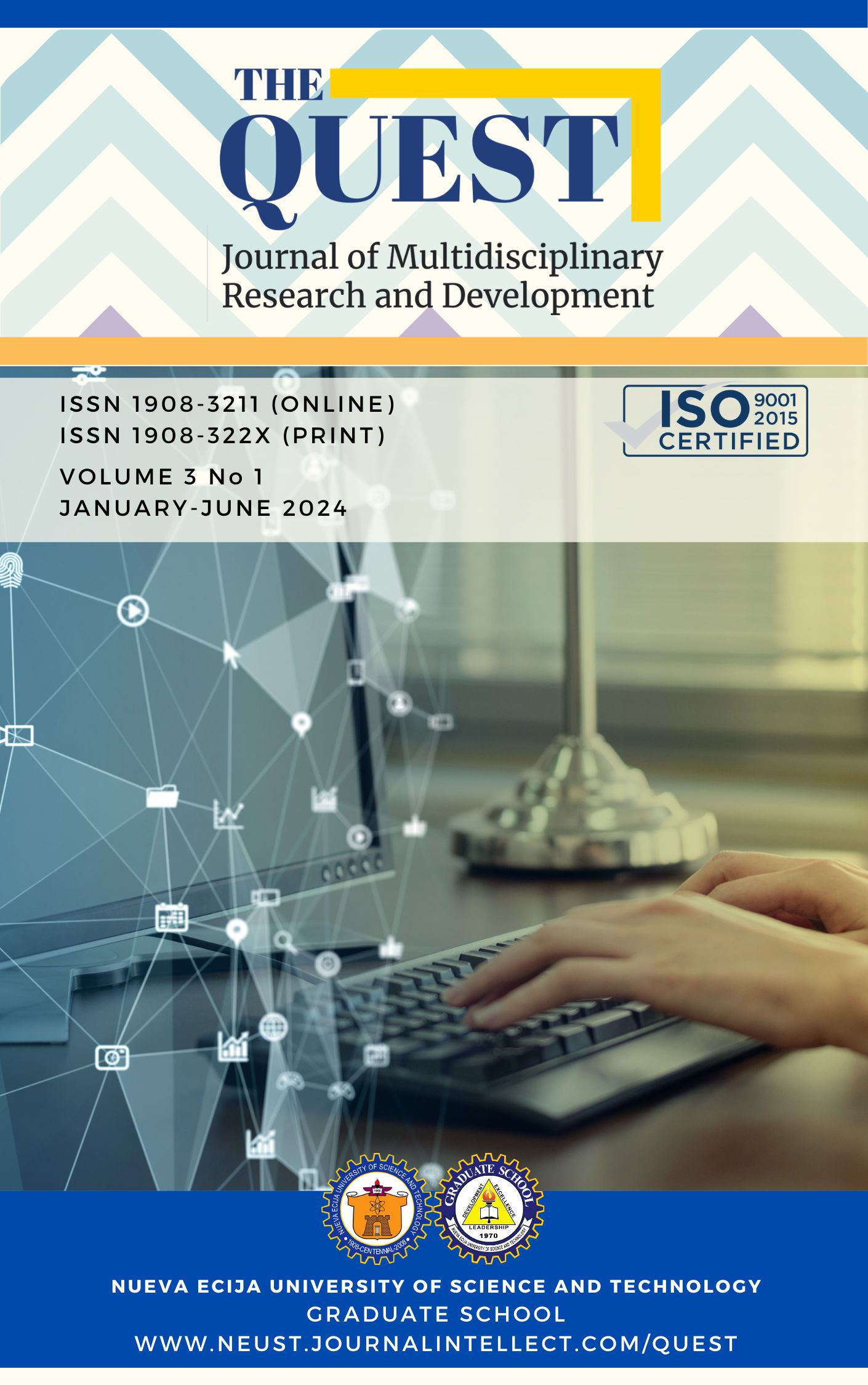Effectiveness of Social Media Platforms as a Reporting Tool in Disaster and Incident Response of the Department of Public Works and Highways, Region III

Published 06/30/2024
Keywords
- Disaster Management; Infrastructure Maintenance; Public Administration; Social Media Platforms; Reporting Tools
How to Cite
Copyright (c) 2024 The QUEST: Journal of Multidisciplinary Research and Development

This work is licensed under a Creative Commons Attribution-NonCommercial 4.0 International License.
Abstract
This study examines the effectiveness of social media platforms as reporting tools for disaster and incident response within the Department of Public Works and Highways (DPWH), Region III. Through a mixed-methods approach, demographic profiles of clientele and DPWH Public Information Officers (PIOs) were analyzed alongside reports received and perceived effectiveness of social media platforms. Purposive sampling was employed to gather responses from 13 clienteles and 33 DPWH PIOs. The demographic analysis revealed that clienteles primarily aged between 25 and 44 years old, with a majority having attained graduate or college degrees and residing in urban areas. DPWH PIOs predominantly fell within the 25 to 34 age range, with most being college graduates and contract-of-service employees. Despite variations in demographics, both clienteles and PIOs perceived social media platforms as effective tools for disseminating information and addressing concerns related to disaster and incident response. Reports received by DPWH Region III through social media platforms highlighted various infrastructure-related issues, including road erosion, drainage problems, and impassable roads due to heavy rainfall. Actions taken in response to these reports included cleaning operations, patching of potholes, and requesting additional funding for infrastructure projects. The perceived effectiveness of social media platforms varied among different demographic groups but generally leaned towards positive evaluations. Challenges encountered in the use of social media as reporting tools included managing the volume of information, ensuring data accuracy and verification, addressing data privacy and security concerns, and managing public expectations. Despite these challenges, both clienteles and PIOs emphasized the importance of social media platforms in facilitating timely communication and response during disaster and incident scenarios.
References
- Baquiran, G. (2022). The Government and the Social Media. https://pia.gov.ph/features/2022/09/19/the-government-and-the-social-media
- Beveridge, C. Tran, T. (2022). Social Media in Government: Benefits, Challenges, and Tactics. https://blog.hootsuite.com/social-media-government/
- Bhuvana, N., & Aram, I. A. (2019). Facebook and Whatsapp as disaster management tools during the Chennai (India) floods of 2015. International journal of disaster risk reduction, 39, 101135.
- Conrado, S. P., Neville, K., Woodworth, S., & O’Riordan, S. (2016). Managing social media uncertainty to support the decision making process during emergencies. Journal of Decision Systems, 25(sup1), 171-181.
- Constantino, L. R., dela Cruz, L. A. L., Dordas, M. D. W., Agustin, N. B., & Ecija, N. Corporate Planning in the Digital Age: Challenges and Opportunities.
- Creswell, J.W. & Creswell, J.D. (2018). Research Design Qualitative, Quantitative, and Mixed Methods Approaches. (5th ed.) Sage
- Cuya-Antonio, O. C. M., Gabriel, A. G., Obispo, C. M., Jacoba, F. P., & Claudio, S. P. (2022). Exploring the leadership behaviors of millennial community leaders during the pandemic: The Case of the Science City of Muñoz in the Philippines. Masyarakat, Kebudayaan & Politik, 35(3).
- Donayre, A.T., Casimiro, R.R. and Molina, E.P. (2020) Awareness and Perception of the Researchers of Philippine Rice Research Institute in Nueva Ecija in the Philippines on the Implementation of New Policy on Research and Publication. Open Access Library Journal, 7: e6077. https://doi.org/10.4236/oalib.1106077
- Feeney, M.K. Porumbescu, G. (2020). The Limits of Social Media for Public Administration Research and Practice. https://www.researchgate.net/publication/342998253_The_Limits_of_Social_Media_for_Public_Administration_Research_and_Practice
- Flash Floods. (n.d.). NATURAL HAZARDS- FLOODS.
- Gabriel, A. G., Santiago, P. N. M., & Casimiro, R. R. (2021). Mainstreaming disaster risk reduction and climate change adaptation in comprehensive development planning of the cities in Nueva Ecija in the Philippines. International Journal of Disaster Risk Science, 12(3), 367-380.http://naturalhazardsjackkelly.weebly.com/flash-floods.html
- Gayeta, M. G. (2021). The Impact of Social Media on Public Relations Practices
- among Information Officers in CAMANAVA and Batangas Philippines. https://eudl.eu/pdf/10.4108/eai.6-3-2021.2306844
- King, L. J. (2018). Social media use during natural disasters: An analysis of social media usage during Hurricanes Harvey and Irma.
- Maynilad Water Services Inc. (2023). Maynilad Water Services, Inc. Facebook
- Page. https://www.facebook.com/MayniladWater
- Talplacido, E. E. P., Zuñiga, M. J. M. B., Yusi, M. D. T., Loria Jr, S. A., & Galang, A. G. (2021). Real-time and automated flood detection &early warning systems for the municipality of san leonardo, nueva ecija: a case study. American Journal of Multidisciplinary Research & Development (AJMRD), 3(11), 28-38.
